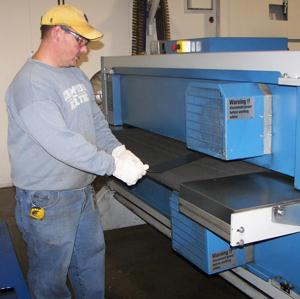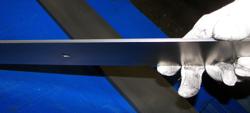Editor-in-Chief
- FMA
- The Fabricator
- FABTECH
- Canadian Metalworking
Categories
- Additive Manufacturing
- Aluminum Welding
- Arc Welding
- Assembly and Joining
- Automation and Robotics
- Bending and Forming
- Consumables
- Cutting and Weld Prep
- Electric Vehicles
- En Español
- Finishing
- Hydroforming
- Laser Cutting
- Laser Welding
- Machining
- Manufacturing Software
- Materials Handling
- Metals/Materials
- Oxyfuel Cutting
- Plasma Cutting
- Power Tools
- Punching and Other Holemaking
- Roll Forming
- Safety
- Sawing
- Shearing
- Shop Management
- Testing and Measuring
- Tube and Pipe Fabrication
- Tube and Pipe Production
- Waterjet Cutting
Industry Directory
Webcasts
Podcasts
FAB 40
Advertise
Subscribe
Account Login
Search
Finishing off oxide layer problems
After years of looking, General Sheet Metal Works found an efficient way to remove oxide from laser-cut steel parts

Figure 1A laser operator runs parts through General Sheet Metal Works' oxide removal machine, which strips the oxide layer from the edges of laser-cut steel sheet metal. Photos courtesy of General Sheet Metal Works.
The problem that General Sheet Metal Works, South Bend, Ind., faced was not unique to those in the metal fabricating industry. Did the company want to stamp a part with sufficient volumes, or did it want to laser-cut it and bypass the cost of building the hard tooling?
The 0.25-inch part wasn't the greatest candidate for the stamping press. Because of its contours, a progressive die was going to have to be built, and that's not an inexpensive proposition.
The steel part was a perfect candidate for the company's 5,000-W laser and press brakes, but Mike Sandsmark, General Sheet Metal Works' facilities manager, said it didn't make financial sense to run the parts with nitrogen during the laser cutting process, given that the cost for nitrogen can be five to six times that of oxygen. Because oxygen adds thermal energy to the laser cutting process, high speeds can be achieved, but oxygen also leaves an oxide layer on the cut's surface, which affects the material's ability to be coated.
In fact, powder coating or wet paint actually adheres to the oxide layer quite nicely. Unfortunately, the oxide layer is not permanently affixed to the steel. If the coating is damaged while the component is in use, sections of the coating layer could flake off. This is particularly true if the product is used outdoors.
Rodger Talbert writes in his book Paint Technology Handbook that sanding, grinding, chipping, and blasting are effective means of removing the oxide layer from laser-cut parts. Manually finishing these parts, he adds, is quite difficult because of high labor costs, inconsistent practices, and odd shapes that are not easily manipulated.
An automated approach to finishing such parts makes the most sense for metal fabricators, and General Sheet Metal Works considered that approach several years ago when it looked at various surface preparation machines.
"They all do a good job, but unfortunately they are combination machines. They do the sanding and everything else," Sandsmark said. "They didn't do a great job [removing the oxide layer]."
Faced with those facts, the company's operations team was stuck with the stamping versus laser cutting conundrum.
A Call for Help
The production puzzle became a little clearer when Sandsmark brought up a conversation he had with another purveyor of an automated oxide removal machine. Sandsmark and the owner of General Sheet Metal Works actually had met the gentleman at a tradeshow several years before, but Sandsmark only recently had engaged in conversations again with the equipment vendor. They agreed it was a good time to chat with Thomas Weinfurtner, vice president of LISSMAC Corp., and they asked him to visit.
LISSMAC, a manufacturer of all sorts of metal processing equipment, was in a unique position because it developed its oxide removal machine as a result of its own internal production needs. In 2002 it began manufacturing the machine for the general sheet metal market.

Figure 2The oxide removal machine has a 60-in.-wide opening and can accommodate multiple parts at one time.
The General Sheet Metal Works team heard about the equipment's virtues, and then traveled to see the machine in operation at a Wisconsin metal fabricating facility.
"We purchased a machine pretty quickly out of that," Sandsmark said.
Laser cutting had won out as the metal fabricating process of choice for the 0.25-in-thick part.
A Clean Slate
What Sandsmark witnessed in Wisconsin was an oxide removal machine that was able to remove all oxide on one pass through the machine. An operator didn't have to take the same part and flip it over so that a set of brushes could then work on the laser-scaled side (see Figure 1).
This is accomplished because the equipment has four brush belts, two at the top and two on the bottom, that run perpendicular to the direction of the conveyor that feeds the parts. One pass through these belts removes the oxide on the inside and outside contours on the edges and in holes and other cutouts.
Weinfurtner said that the brush belts keep any protective oil film on the sheets intact.
Sandsmark said it takes about 20 or 30 seconds to feed the parts through the machine. The machine can process parts up to 12 FPM.
General Sheet Metal Works purchased the SBM-B 1500, which has a 60-in.- wide opening. Sandsmark said that the laser operators are able to put five or six smaller parts across the conveyor's width at one time (see Figure 2), which greatly increases the parts-cleaned-per-second rate. On the other side, the laser operators also send large mower decks made of 7-gauge steel through the machine prior to forming on the press brake.
The machine can accommodate parts up to 0.75 in. thick. Sandsmark said that they try to avoid sending too many really thick parts through the machine because they are much harsher on the brushes than the lighter-gauge parts. Operators alter the brush belts with a crank handle.
"You can adjust the speed, but we usually don't adjust it," Sandsmark said.

Figure 3At slower speeds, the oxide removal machine can remove all of the oxide created by laser cutting with oxygen. However, in some instances complete removal of the oxide layer may not be necessary.
Another Machine in the Future?
Today the 107.5- by 59.1- by 60.2-in. machine sits in the middle of four laser cutting machines. Truthfully, some of the lasers are cutting with nitrogen most of the time, but for those laser-cut parts with an oxide layer on the edges, the machine is more than able to keep up with the parts flow.
"Usually the laser operators will go over there, and there will be one guy on each side of the machine, one guy putting them in and one guy picking them up and stacking them," Sandsmark said.
That's been a plus for cost estimating because the front office can quote laser cutting jobs with oxygen and not have to worry about increased labor cost. The laser operators are already accounted for in the estimate, and they have proven capable of handling the additional metal finishing duties.
It's also opened up work for the company's 2,000- and 2,500-W machines that really didn't have the power to cut with nitrogen; now parts can be cut with oxygen on those machines and finished up on the oxide removal machine.
As for maintenance, Sandsmark said the new oxide removal machine isn't a big deal. He said it took him less than two hours to replace all the brush belts in the unit, which took place about three months ago at the time of this interview. Someone also vacuums the dust out of the machine itself and in the trays at the machine's base.
"Ninety or 95 percent of the material that we run through is pickled in oil, so that keeps the dust down," he added.
The machine definitely has provided General Sheet Metal Works with flexibility in the way it approaches laser cutting. Sandsmark said he thinks other fabricators may look long and hard at oxide removal technology, particularly as they look to reign in costs associated with consumables.
Meanwhile, his company is thinking about adding a second machine. That's a nice finish to what was a pretty challenging metal fabricating problem.
Just How Much Oxide Needs to Be Removed?
General Sheet Metal Works, South Bend, Ind., doesn't powder-coat parts, but its customers do. Little did it know that when it bought its SBM-B from LISSMAC Corp., the company might be in a position to teach its powder-coating customers a thing about finishing.
Mike Sandsmark, General Sheet Metal Works' facilities manager, said he learned from the European equipment vendor that only about 70 percent of the oxide needs to be removed from an edge laser-cut with oxygen in order to meet quality standards for powder coating (see Figure 3).
"Once we ran sample parts, we went to our customers and asked, 'Hey, will these work?'" Sandsmark said. "They came back and said, 'Yes, you have removed enough oxidation.' Even our customers learned a little bit and realized that their parts don't have to be 100 percent oxide-free."
Thomas Weinfurtner, vice president, LISSMAC Corp., said that many OEMs still demand that 100 percent of the oxide layer be removed, but some metal product manufacturers have come around to accepting less than complete oxide removal.
Weinfurtner added that the complete removal of oxide usually has to do with the metal fabricator's production needs. If the fabricator needs the oxide removal machine to operate at around 8 FPM, it will have to live with a small amount of oxide remaining on the edges, unless it elects to feed the parts through the machine again. At speeds around 3 FPM, a fabricator can feel comfortable that almost 100 percent of the oxide has been removed from all contours.
About the Author

Dan Davis
2135 Point Blvd.
Elgin, IL 60123
815-227-8281
Dan Davis is editor-in-chief of The Fabricator, the industry's most widely circulated metal fabricating magazine, and its sister publications, The Tube & Pipe Journal and The Welder. He has been with the publications since April 2002.
Related Companies
subscribe now

The Fabricator is North America's leading magazine for the metal forming and fabricating industry. The magazine delivers the news, technical articles, and case histories that enable fabricators to do their jobs more efficiently. The Fabricator has served the industry since 1970.
start your free subscription- Stay connected from anywhere

Easily access valuable industry resources now with full access to the digital edition of The Fabricator.

Easily access valuable industry resources now with full access to the digital edition of The Welder.

Easily access valuable industry resources now with full access to the digital edition of The Tube and Pipe Journal.
- Podcasting
- Podcast:
- The Fabricator Podcast
- Published:
- 04/16/2024
- Running Time:
- 63:29
In this episode of The Fabricator Podcast, Caleb Chamberlain, co-founder and CEO of OSH Cut, discusses his company’s...
- Industry Events
16th Annual Safety Conference
- April 30 - May 1, 2024
- Elgin,
Pipe and Tube Conference
- May 21 - 22, 2024
- Omaha, NE
World-Class Roll Forming Workshop
- June 5 - 6, 2024
- Louisville, KY
Advanced Laser Application Workshop
- June 25 - 27, 2024
- Novi, MI































